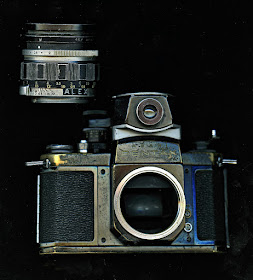My architect friend Abraham Rogatnick died about five years
ago. A year before he did, he often told me, “I am going to die in a year. I am
not long for this world and I am glad for it.”
In many ways, I am now 75 (he was 82), I am beginning to
understand him. The thought of a park bench with my name in Cate's Park is not exciting.
Mine was a life of cellophane, Xerox, Pontiacs, Studebakers,
Kodak, Agfa, Ferrania, Borgwards, Rhodesia, dial phones, DC-6s and
Constellations, Pentaxes and Nikons FM-2, Popular Mechanics and a good
Vancouver Sun. I was proud that I was working (many years) for a publication
called the Georgia Straight. I have a theory that the Vancouver Sun began to decline as soon as they dedicated whole sections of the paper to the Sun Run.
In that former world I was in a first person relationship
with my Fedex man. I would send my transparencies to Toronto, New York and
other parts of the world via him.
Magazines would pay me to go to Europe, Florida, Mexico and
South America to take photographs. I soon learned to sweet talk security at
airports not to X-Ray my film.
That world is gone.
My doctor is retiring on August 31st
and he cannot find anybody to take his practice. He tells me that many people
now self-diagnose on the internet.
That world of Irving Penn, Bert Stern, Richard Avedon,
George Hurrell, Philippe Halsman (Annie Leibovitz is still around) has disappeared. I
cannot find a photographer to emulate, to admire, to imitate.
My world was one in which we all accepted “Form follows
function,” as a necessary fact of life.
To me, as I see it we have been taken over by the idea of “Function
follows form.”
This means that in my life cameras are getting much more
complicated. We have to accept this complication as this is supposed to be a
better feature.
I have learned to use my Fuji X-E1 after five years. My
newer X-E3 is much more complex. In order to remove the random event of my
camera going into a double exposure mode (ample proof that inanimate objects
have free will) the instruction manual is no help. I found the solution by
accident. This solution would have been patently obvious to a young Japanese
designer who may not know who Daguerre was.
Randomly the X-E3 will show a horizon in the viewfinder much
like the one on an airplane pilot’s instrument panel. I don’t need it. I don’t
want it. And so on.
Today my Galaxy phone informed me that I had an unregistered
SIM card. I could not use the phone as a phone. A quick trip to Telus around
the corner and the man there told me he had never seen this before. But he
turned off the phone and turned it on again. My SIM card was now registered.
If I were 35 I would market (after consulting an expert) a
button that would freeze all wanted functions in my phone and camera and ward
off horizons and unregistered SIM cards.
It was the Jesuit philosopher Pierre Teilhard de Chardin who
wrote how organisms from the beginning of our world went, irrevocably from simplicity to
complexity. I would now tell him that there would have to be some exceptions.
My phone and my camera are almost organisms but they should not be so complex
that they rule me and me not them.
For a week my little green light in my phone that looks for
WiFi turned itself off and I used data. I never chose to undo my WiFi
search. The phone did this on its own volition.
Seen here is the third camera I bought. I got it at Foto
Rudiger on Avenida Venustiano Carranza in Mexico City in 1962. It works
beautifully and it has no built in horizon indicator. I happen to sometimes
like the Dutch Tilt.
There is a beauty to this Asahi Pentax S-3 that has all to do with form follows function.
